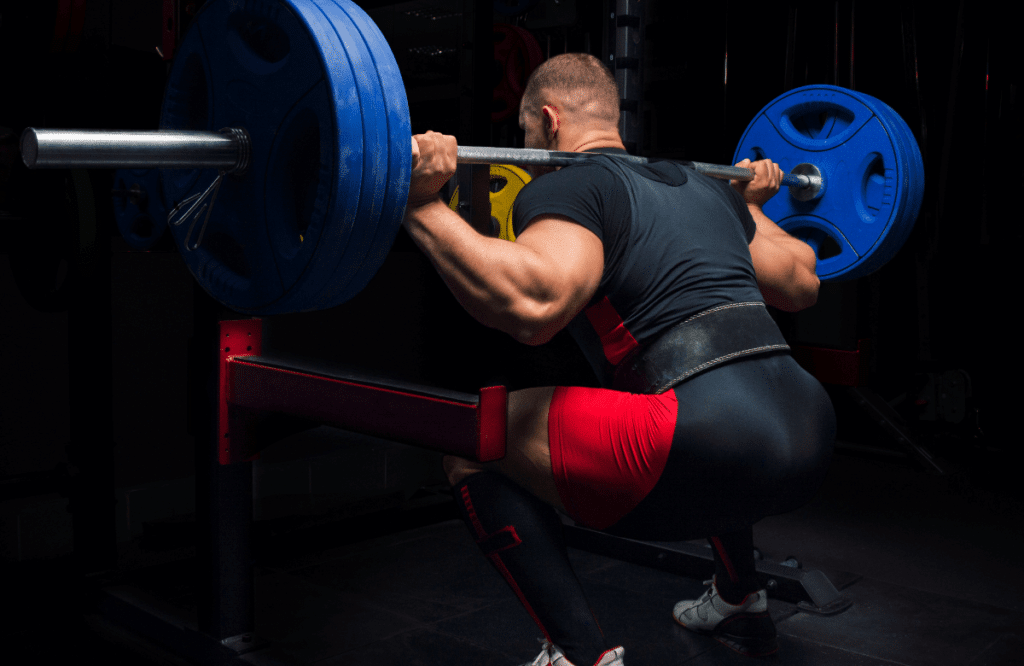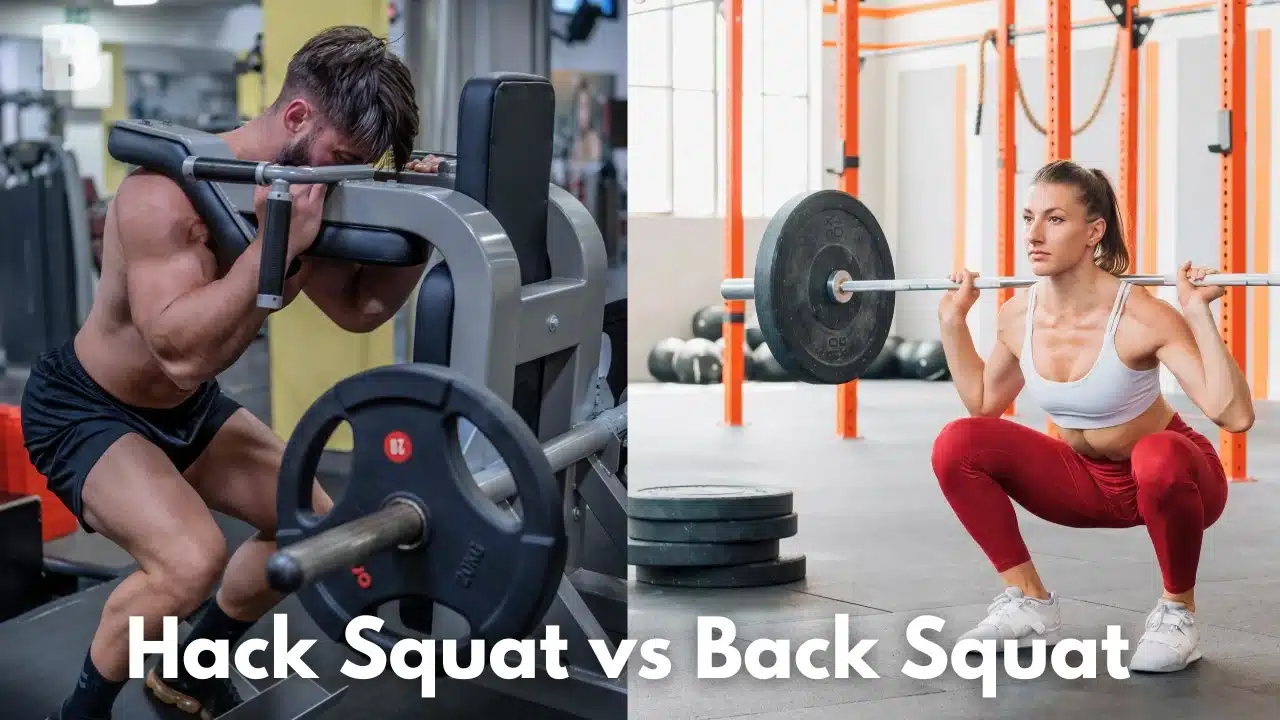Of all the leg exercises, the hack squats are one of the least popular. You see people performing back squats all the time, but the hack squat barely gets a look in.
Are people missing out on potential game-changing fitness benefits by not performing hack squats, or are they a vanity exercise that we can replicate in other ways? Are they an ineffective version of other squats, with a high injury risk and little to no tangible benefit?
In this article on hack squats vs back squats, I’m going to look in depth at both movements. I’m going to review the research, giving a scientific edge to the discussion. Through the article I’ll be comparing the use case of the two movements, leaving you with an informed opinion on which is best, when and why.
On to hack squats vs back squats…
Jump to:
- What’s a Hack Squat?
- What’s a back squat?
- How does a back squat work?
- Hack squat vs Back squat – the good…
- What’s good about a hack squat?
- What’s good about a back squat?
- Which is easiest to learn?
- Is a hack squat better than a back squat? What does science say?
- When would you use a hack squat?
- Injury risk of hack squat vs back squat
- When would you use a back squat?
- Hack squats vs Back squats – Final thoughts
What’s a Hack Squat?
A hack squat is a compound lower-body exercise that targets the quadriceps, hamstrings, and glutes.
There are two main versions of a hack squat – one with a machine, one with a barbell.

Machine Hack squat
Many commercial gyms will have a Hack squat machine, or a variation of the leg press.
The machine Hack squat exercise is performed using a specialized piece of equipment that supports your upper body while your feet are placed on a platform. You drive up from the platform, keeping your feet on the floor and your back pushed against the pad.
- Start by positioning yourself in the Hack Squat machine with your back against the backrest and your shoulders under the shoulder pads.
- Place your feet shoulder-width apart on the platform.
- Lower the weight by bending your knees, keeping your back straight.
- Push the weight back up by extending your knees and hips.
Here’s what a hack squat machine looks like in use…
Barbell Hack squat
The barbell Hack squat is the free weight equivalent of the movement. You don’t need a squat rack, just a barbell and plates to perform the exercise. It’s unlike any squat you would have performed before.
- Place a loaded barbell close behind you.
- Keeping your back straight, bend at the knee and grasp the bar with a double overhand grip.
- Stand upright, keeping the bar close behind you.
- Repeat as necessary.
Here’s what a barbell hack squat looks like…
What’s a back squat?
A back Squat is the classic squat that you would have seen thousands of times in the gym.
It’s a huge leg exercise that targets multiple muscle groups, including the quadriceps, hamstrings, glutes, lower back, and core. You use a barbell placed on your upper back while performing a squatting motion. There are nuances (high bar, low bar, foot position etc), but they’re variations of the same thing.
How does a back squat work?
- Begin by standing with your feet shoulder-width apart, with the barbell resting on your upper back.
- Lower your body by bending your knees and hips, maintaining a straight back and keeping the barbell stable.
- Descend until your thighs are parallel to the ground or lower.
- Push the weight back up by extending your knees and hips.
Hack squat vs Back squat – the good…
I’m a firm believer that almost all exercises aren’t ‘good’ or ‘bad’ – it depends on the situation.
For example, chin ups are a great exercise, but I wouldn’t use them to build my calf muscles. So to give each exercise a fair chance in this analysis, I’m going to look at their positives…

What’s good about a hack squat?
- Reduced Lower Back Stress: Hack Squats are generally easier on the lower back because of the vertical torso position.
- Isolation of Quadriceps: The exercise places a significant emphasis on the quadriceps, making it an effective choice for targeting this muscle group.
- Good for confidence: Some lifters don’t have the confidence to get under a bar and hit depth. The hack squat can make this process easier.
- No need to worry about technique: A back squat can be a challenging exercise, whereas a hack squat isn’t. The machine dictates the movement.
- Range of motion: For people who lack mobility (sometimes though muscle stiffness, sometimes through injury), the hack squat can help them with their range of motion.
What’s good about a back squat?
- Full-Body Engagement: When performed with correct form, back squats engage multiple muscle groups, including the lower back, glutes, and hamstrings.
- Functional Strength: Because of its resemblance to everyday movements like sitting down and standing up, back squats can improve functional strength.
- Stabilizer muscle activation: Squats are inherently unstable, so they switch on all of those smaller stabilizing muscles.
- Skill development: Squats are a key movement pattern in many other lifts and skills, so play an important role in helping people develop and improve foundational movement patterns.
- Equipment requirements: True Hack squats require a machine, whereas a back squat only needs a barbell and weight plates.
Which is easiest to learn?
For beginners, machine Hack Squats are often easier to learn and execute. The machine provides stability, reducing the risk of improper form. The barbell hack squat is an advanced exercise and should only be performed by competent, flexible and strong lifters.
Back squats require more balance and technique, making them more challenging for newcomers.
The ranges of motion in back squats often take longer to develop, but the benefit is healthier knee joints, more core strength and greater engagements of the overall thigh muscles with the traditional back squat.
They both work well when programmed together.
Is a hack squat better than a back squat? What does science say?
As I mentioned before, neither exercise is better than the other; it depends on your goals and individual circumstances.
If you want to minimize lower back stress or isolate the quadriceps, a Hack squat may be preferable to a back squat.
However, if you’re looking for a higher muscle engagement and improved functional strength, Back Squats are a great choice.
Here’s a snapshot of the science comparing different squat types…
In a 2020 study titled ‘Evaluation of Muscle Activities During Different Squat Variations Using Electromyography Signals‘, researchers concluded that…
EMG activities of Erector spinae and semitendinosus during Hack squat were significantly lower than all other squat variations. These findings may suggest that squats may be chosen to focus on quadriceps muscles while Hack squat may be a good choice for better knee and spinal stabilization.
In English this means that a machine as opposed to free weights reduces the amount of loading on the trunk. This lowers the amount of muscle activation in the back when performing the hack squat. However, the hack squat still appears to stimulate the quad muscles effectively.
These results echo a 2019 study by Clark et al titled ‘Trunk Muscle Activation in the Back and Hack Squat at the Same Relative Loads‘. Their research led them to draw the following conclusions…
‘Back squat is more effective than Hack squat in activating the muscles of the trunk and therefore, arguably more effective in developing trunk strength and stability for dynamic athletic performance.’
This suggests that if your focus is skill development, back strength of general strength, go for the back squat. They do say in the study that the leg muscle recruitment was largely similar though, so they’re equal from a leg activation point of view.
When would you use a hack squat?
There’s a time and a place for most exercises, the hack squat included. Although the research above suggests that the overall muscle stimulation is better with the traditional squat, there’s still times when hack squats are useful.
Here’s a few…
- Rehabilitation: If you’re recovering from a lower back injury but still want to train your legs, Hack squats can be a safe option. The hack machine allows you to work and build your leg strength without stressing the back.
- Targeted Quadriceps Training: If your goal is to target and develop your quadriceps, Hack squats can be effective. They allow maximum quad engagement, helping to build those crucial leg muscles.
- Controlled depth: If your range of movement is limited thanks to confidence, the hack squat machine allows you to get a deeper squat than traditional barbell squat. It’s also a good way to build confidence at heavier weights.
- Variation: Incorporating Hack Squats into your routine adds variety to your workouts, preventing plateaus. Research shows that sometimes a new stimulus is an effective way to change things up. Adding the hack squat into your leg training routine can do this.
Injury risk of hack squat vs back squat
Both exercises come with some risk of injury if performed with improper form or excessive weight. However, machine hack squats may be less likely to cause lower back injuries due to the machine’s design and movement control.
With the back squat, you’ve got to be careful about knee issues, hip issues and lower back issues. They’re not as common in a hack squat, because the machine is in control of your movement patterns.
There’s a higher chance of injury with the barbell hack squat, and to be honest it’s not an exercise I’m a fan of. There’s a temptation to ’round’ the back, which comes with its own risks. I’ve also (anecdotally) heard of lower back issues thanks to poor range of movement.
A barbell hack squat should only be performed if you have sufficient strength and mobility to perform the movement safely.
As with any exercise, always prioritize proper form and start with lighter weights to minimize injury risk.

When would you use a back squat?
Back squats remain one of the most popular exercise patterns of them all. They’re effective, build huge lower body strength, are versatile and can be used for all kinds of reasons, from rehab to performance. Here’s some of the reasons you’d use them over a hack squat…
- Full body development: Back Squats engage multiple muscle groups, making them an efficient choice for overall strength and muscle development. Although they’re designed for leg training, they build strength in the lower back and core too.
- Functional fitness: If you want to improve your ability to perform everyday tasks and sports activities, Back squats are very beneficial. Movement quality and skill adoption is improved when we perform more neurally-demanding tasks, and that’s the case with a back squat. Certainly more so than machine-based exercises.
- Building specific strength: If you’re performing a sport such as weightlifting, powerlifting, jump sports, sprinting etc, squats will be particularly useful. They build strength through a natural range, rather than a fixed path.
- Variety: When you squat you can adjust the movement more than you can with a machine. You can adjust your foot placement, the bar height, your positioning on the way down etc. It’s a more natural movement than on a machine.
- Specific rehab and strength improvement patterns: If you’ve had a lower body injury and need to rehab a specific element of your movement, squats are a great way to do it. It’s also the same with working on a specific element of fitness. You can control movement with free weights in a way you can’t with machines.
Hack squats vs Back squats – Final thoughts
In the debate of hack squats vs. back squats, there’s no one-size-fits-all answer. They’re both useful in their own right.
The best choice depends on your goals, fitness level, and any pre-existing injuries or limitations. It’s also worth noting that you don’t have to choose one over the other exclusively. Many individuals incorporate both hack squats and back squats into their workout routines to reap the unique benefits of each exercise.
The key to success with either exercise is maintaining proper form, increasing weight, and staying consistent with your training.
What the research has shown us is that when it comes to leg engagement, it’s a draw. They both have a place in a training program. Both free weight squats and hack squats will engage the quads and build muscle mass in the legs.
However, the regular squats offer more overall muscle stimulation. You’ll engage more of the core and lower body muscles with the free weight squats, and that’s an important distinction. It’ll make your workouts more efficient, and more beneficial.
If you get to do both, you’re going to enjoy a great leg workout! If it was a choice between either one, it’s got to be back squats for me.














